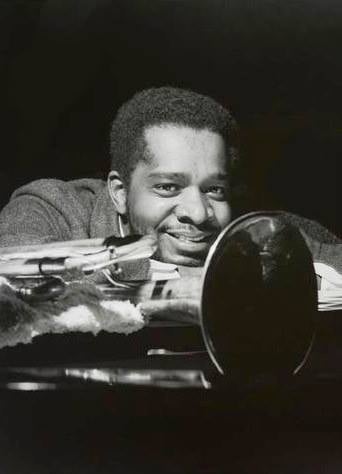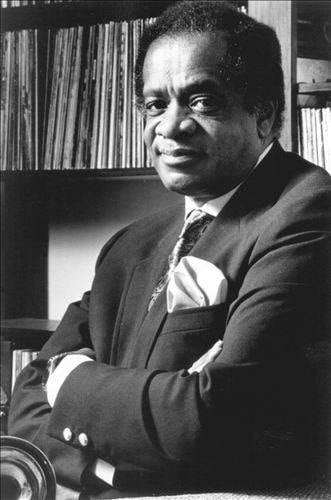February 4, 2013 – Donald Byrd Jr. died at age 80 in Dover, Delaware
Byrd was a jazz and R&B sideman for many other jazz musicians of his generation, best known as one of the only bebop jazz musicians who successfully pioneered the funk and soul genres while simultaneously remaining a jazz artist. As a bandleader, Byrd is also notable for his influential role in the early career of keyboard player and composer Herbie Hancock.
Byrd attended Cass Technical High School. He performed with Lionel Hampton before finishing high school. After playing in a military band during a term in the United States Air Force, Byrd obtained a bachelor’s degree in music from Wayne State University and a master’s degree from Manhattan School of Music. While still at the Manhattan School, he joined Art Blakey’s Jazz Messengers, as replacement for Clifford Brown. In 1955, he recorded with Gigi Gryce Jackie McLean and Mal Waldron. After leaving the Jazz Messengers in 1956, he performed with many leading jazz musicians of the day, including John Coltrane, Sonny Rollins, Thelonious Monk, and later Herbie Hancock. Byrd’s first regular group was a quintet that he co-led from 1958 to 1961 with baritone saxophonist Pepper Adams, an ensemble whose hard-driving performances are captured “live” on “At the Half Note Café”.

Byrd’s 1961 LP “Royal Flush” marked the Blue Note debut of Hancock, who came to wider attention with Byrd’s successful 1962 album “Free Form”, and these albums also featured the first recordings of Hancock’s original compositions. Hancock has credited Byrd as a key influence in his early career, recounting that he took the young pianist “under his wings” when he was a struggling musician newly arrived in New York, even letting him sleep on a hide-a-bed in his Bronx apartment for several years:
He was the first person to let me be a permanent member of an internationally known band. He has always nurtured and encouraged young musicians. He’s a born educator, it seems to be in his blood, and he really tried to encourage the development of creativity.
Hancock also recalled that Byrd helped him in many other ways: he encouraged Hancock to make his debut album for Blue Note, connected him with Mongo Santamaria, who turned Hancock’s tune “Watermelon Man” into a chart-topping hit, and that Byrd also later urged him to accept Miles Davis’ offer to join his quintet.
Hancock also credits Byrd with giving him one of the most important pieces of advice of his career – not to give away his publishing. When Blue Note offered Hancock the chance to record his first solo LP, label executives tried to convince him to relinquish his publishing in exchange for being able to record the album, but he stuck to Byrd’s advice and refused, so the meeting came to an impasse. At this point, he stood up to leave, but when it became clear that he was about to walk out, the executives relented and allowed him to retain his publishing. Thanks to Santamaria’s subsequent hit cover version of “Watermelon Man”, Hancock was soon receiving substantial royalties, and he used his first royalty check of $3000 to buy his first car, a 1963 Shelby Cobra (also recommended by Byrd) which Hancock still owns, and which is now the oldest production Cobra still in its original owner’s hands.
By 1969’s “Fancy Free”, Byrd was moving away from the hard bop jazz idiom and began to record jazz fusion and rhythm and blues. He teamed up with the Mizell Brothers (producer-writers Larry and Fonce) for “Black Byrd” (1973) which was, for many years, Blue Note’s best-selling album. The title track climbed to #19 on Billboard′s R&B chart and reached the Hot 100 pop chart, peaking at #88. The Mizell brothers’ follow-up albums for Byrd, “Street Lady”, “Places and Spaces” and “Stepping into Tomorrow”, were also big sellers, and have subsequently provided a rich source of samples for acid jazz artists such as Us3. Most of the material for the albums was written by Larry Mizell. In 1973, he helped to establish and co-produce the Blackbyrds, a fusion group consisting of then-student musicians from Howard University, where Byrd taught in the music department and earned his J.D. in 1976. They scored several major hits including “Happy Music” (#3 R&B, # 19 pop), “Walking in Rhythm” (#4 R&B, #6 pop) and “Rock Creek Park”.

During his tenure at North Carolina Central University during the 1980s, he formed a group which included students from the college called the “125th St NYC Band”. They recorded the “Love Byrd” album, which featured Isaac Hayes on drums. “Love Has Come Around” became a disco hit in the UK and reached #41 on the charts. Byrd’s chops steadily declined from the mid 80’s on and he sporadically recorded. He was a central figure in the Jazz hip hop movement of the early 90’s, appearing and performing with rapper Gangstarr, and continued his teaching career,
Beginning in the 1960s, Byrd (who eventually took his PhD in music education from Teachers College, Columbia University in 1982) taught at a variety of postsecondary institutions, including Rutgers University, the Hampton Institute, New York University, Howard University, Queens College, Oberlin College, Cornell University, North Carolina Central University and Delaware State University. Byrd returned to somewhat straight-ahead jazz later in his career, releasing three albums for Orrin Keepnews’ Landmark Records, and his final album “Touchstone”, a quintet.
SOURCES:
http://www.bluenote.com/artists/donald-byrd
http://www.newyorkjazzworkshop.com/donald-byrd/
http://www.soulwalking.co.uk/Donald%20Byrd.html
https://soul-sides.com/…/the-many-flights-of-donald…
https://www.allmusic.com/…/donald-byrd…/biography
https://www.npr.org/…/remembering-donald-byrd-jazz…
https://en.wikipedia.org/wiki/Donald_Byrd